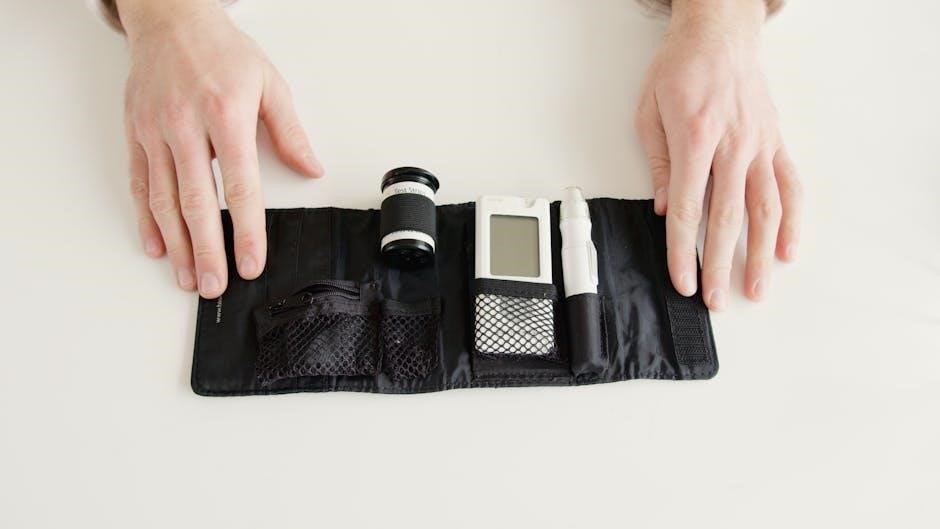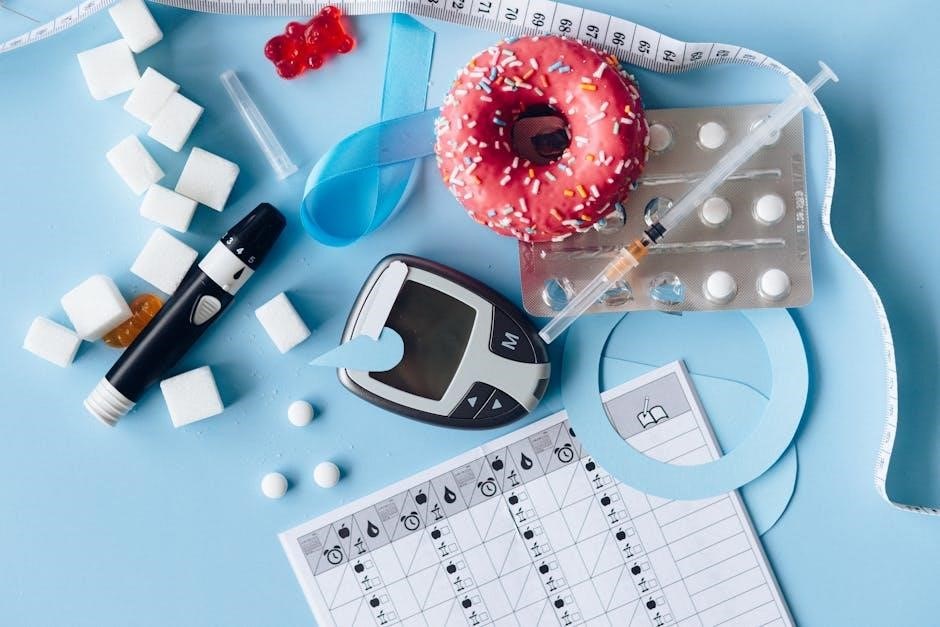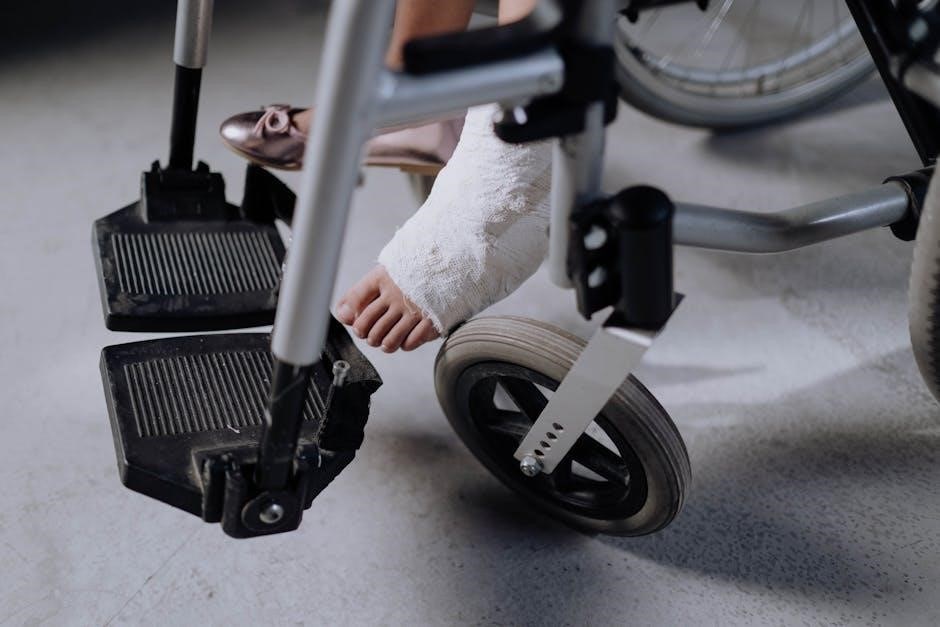Overview of Joint Commission Medication Management Standards
The Joint Commission’s medication management standards ensure safe, effective, and high-quality care. These standards address medication ordering, storage, dispensing, and administration, emphasizing patient safety and regulatory compliance. They guide healthcare organizations in reducing errors and adverse drug effects through standardized protocols and continuous improvement strategies.
The Joint Commission’s medication management standards are designed to ensure safe, effective, and high-quality patient care. These standards provide a framework for healthcare organizations to manage medications across the continuum of care, from ordering to administration. The standards emphasize the importance of clear protocols, proper documentation, and ongoing monitoring to minimize errors and adverse drug events. They also require organizations to maintain accurate records and ensure compliance with regulatory requirements. The Joint Commission’s standards are regularly updated to reflect best practices, emerging trends, and patient safety priorities. By adhering to these standards, healthcare organizations can improve medication safety, reduce risks, and enhance patient outcomes. The standards also emphasize the role of education and training for healthcare staff to ensure competency in medication management. Overall, the Joint Commission’s standards serve as a benchmark for excellence in medication management, guiding organizations toward continuous improvement and accountability.

1.2 Importance of Medication Management in Healthcare

Medication management plays a critical role in ensuring patient safety, improving healthcare outcomes, and reducing medical errors. Proper management of medications is essential to prevent adverse drug events, which can lead to prolonged hospital stays, increased costs, and even patient harm. Effective medication management ensures that patients receive the right medication, in the right dose, at the right time, and via the right route. This process also helps in minimizing medication errors, which are a leading cause of preventable harm in healthcare settings. Additionally, proper medication management enhances the quality of care by ensuring that medications are used appropriately and safely. It also supports the coordination of care across different healthcare settings, such as hospitals, clinics, and long-term care facilities. By prioritizing medication management, healthcare organizations can improve patient satisfaction, reduce readmissions, and enhance overall public health outcomes. The Joint Commission’s standards emphasize the importance of robust medication management systems to achieve these goals and maintain high standards of patient care.

Key Components of Medication Management Standards
Medication management standards focus on safe and effective practices, including proper ordering, storage, dispensing, and monitoring. These components ensure accurate medication use, minimize errors, and promote patient safety across healthcare settings.
2.1 Medication Ordering and Protocols
Medication ordering and protocols are critical components of the Joint Commission’s medication management standards. These standards emphasize the importance of accurate and clear medication orders to ensure patient safety. Healthcare organizations must establish robust protocols for prescribing medications, including the use of standardized order sets and evidence-based guidelines. Proper authorization, legibility, and completeness of orders are essential to prevent errors. Additionally, protocols should address high-alert medications, which pose a higher risk of adverse effects, requiring extra safeguards. The development of these protocols often involves a multidisciplinary team, including physicians, pharmacists, and nurses, to ensure they are practical and effective. Regular reviews and updates of ordering protocols are necessary to align with current medical knowledge and regulatory requirements. By adhering to these standards, healthcare providers can minimize medication errors, improve therapeutic outcomes, and maintain compliance with accreditation guidelines. Effective medication ordering and protocols are foundational to safe and reliable medication management systems.
2.2 Medication Storage and Security
Medication storage and security are vital aspects of the Joint Commission’s medication management standards. Proper storage ensures medications remain effective and are protected from environmental factors such as light, moisture, and temperature fluctuations. Healthcare facilities must maintain secure storage areas to prevent unauthorized access, theft, or diversion of medications, particularly for controlled substances. Access to medication storage areas should be restricted to authorized personnel, with clear policies for key management or electronic access controls. Additionally, medications must be stored in accordance with manufacturer guidelines and labeled clearly to avoid mix-ups. The Joint Commission also emphasizes the importance of separating expired, recalled, or hazardous medications from active inventory to prevent accidental use. Regular audits and inventory checks are required to ensure compliance with storage and security protocols. Proper medication storage and security practices not only safeguard patient care but also help maintain regulatory compliance and reduce risks associated with medication diversion or misuse.
2.3 Medication Dispensing and Administration

Medication dispensing and administration are critical steps in the medication management process, requiring precise adherence to Joint Commission standards. Dispensing involves the accurate preparation and issuance of medications, ensuring the right medication, dose, and form are provided to the right patient. Healthcare facilities must implement barcode medication administration (BCMA) systems to enhance accuracy and reduce errors during administration. Nurses and healthcare providers should verify medications against the patient’s orders and use two patient identifiers to ensure safe administration.
Additionally, medications must be administered within the prescribed time frames, and any delays or missed doses should be documented and addressed promptly. The Joint Commission emphasizes the importance of monitoring high-alert medications, such as opioids and anticoagulants, to prevent adverse events. Proper documentation of administration, including time, dose, and route, is essential for maintaining accurate patient records. Automated dispensing cabinets (ADCs) are often used to streamline the dispensing process while maintaining security and accountability.
Training and competency assessments for staff involved in dispensing and administration are crucial to ensure compliance with these standards and promote patient safety.

Compliance and Regulatory Requirements
Compliance with Joint Commission standards ensures medication management aligns with legal and regulatory expectations. Facilities must adhere to state and federal laws, maintain accurate records, and conduct regular audits to verify adherence to safety protocols and documentation standards.
3.1 Ensuring Compliance with Joint Commission Standards
Ensuring compliance with Joint Commission medication management standards requires a structured approach to adhere to regulatory and safety guidelines. Healthcare organizations must establish clear policies and procedures that align with these standards, ensuring all staff are trained and competent in medication management practices. Regular audits and performance improvement initiatives help identify gaps and implement corrective actions. Documentation is critical, with accurate records maintained for medication orders, administration, and patient responses. Interdisciplinary collaboration among pharmacists, nurses, and physicians ensures safe and effective medication use. Organizations must also stay updated on any revisions to Joint Commission standards and integrate changes promptly. Compliance is not just about meeting requirements but also fostering a culture of patient safety and continuous improvement. By adhering to these standards, healthcare facilities reduce medication errors and enhance overall quality of care.
3.2 Role of Technology in Medication Management
Technology plays a pivotal role in enhancing medication management by improving accuracy, efficiency, and patient safety. Electronic Health Records (EHRs) and Computerized Physician Order Entry (CPOE) systems reduce errors by standardizing medication orders and eliminating illegible handwriting. Automated dispensing cabinets (ADCs) and barcode medication administration (BCMA) systems ensure medications are dispensed and administered correctly, with real-time tracking. These tools help organizations comply with Joint Commission standards by providing audit trails and generating reports for performance monitoring. Additionally, clinical decision-support systems (CDSS) alert healthcare providers to potential drug interactions, allergies, and dosing errors, further minimizing risks. Technology also facilitates secure storage and tracking of controlled substances, preventing diversion and misuse. By integrating these advanced systems, healthcare facilities can streamline workflows, reduce human error, and ensure adherence to medication management standards. Technology not only supports compliance but also elevates the quality of care, making it a cornerstone of modern medication management practices.

Patient Safety and Education
Patient safety and education are critical in medication management, ensuring patients understand their treatments and potential risks. The Joint Commission emphasizes patient involvement to prevent errors and improve outcomes through clear communication and adherence to safety practices.

4.1 Patient Education on Medication Use
Patient education is a cornerstone of effective medication management, as outlined in the Joint Commission standards. Clear communication ensures patients understand their medications, dosages, and potential side effects, fostering safer use and better adherence. Healthcare providers must use plain language, avoiding medical jargon, and provide written instructions to reinforce verbal guidance. Accessibility is key; materials should be tailored to patients’ literacy levels and language preferences, with visual aids or translations when necessary. This personalized approach helps bridge gaps and ensures understanding, reducing the risk of errors. By empowering patients with knowledge, healthcare systems promote autonomy and active participation in care, leading to improved health outcomes and safer medication practices.
4.2 Monitoring for Adverse Drug Effects
Monitoring for adverse drug effects is a critical component of medication management, as emphasized by the Joint Commission standards. This process ensures patient safety by identifying and addressing potential harm caused by medications. Healthcare providers must implement systematic approaches to detect adverse drug reactions (ADRs) early, including regular patient assessments, laboratory tests, and documentation of symptoms. Staff must be trained to recognize signs of ADRs, such as unusual side effects or unexpected changes in a patient’s condition. Clear communication among healthcare team members is essential to promptly address and document these incidents. Additionally, healthcare facilities should establish protocols for reporting and managing ADRs, ensuring transparency and continuous improvement in care. By prioritizing monitoring, organizations can reduce medication-related complications and improve overall patient outcomes. The Joint Commission also recommends leveraging technology, such as electronic health records, to enhance surveillance and reporting mechanisms. Proactive monitoring not only enhances safety but also aligns with broader goals of quality care and patient-centered practices.

The Joint Commission’s medication management standards play a critical role in ensuring patient safety and proper medication use. These standards guide healthcare providers in implementing safe practices, promoting continuous improvement, and enhancing overall care quality.
5.1 Summary of Medication Management Standards
The Joint Commission’s medication management standards provide a comprehensive framework to ensure safe and effective medication use in healthcare settings. These standards emphasize a patient-centered approach, focusing on clear medication ordering, secure storage, accurate dispensing, and proper administration. They also stress the importance of patient education, monitoring for adverse drug effects, and continuous quality improvement. By adhering to these standards, healthcare organizations can reduce medication errors, improve patient outcomes, and maintain compliance with regulatory requirements. The standards also highlight the role of technology, such as electronic health records and barcode medication administration systems, in enhancing medication safety. Overall, the Joint Commission’s medication management standards serve as a foundation for healthcare providers to deliver high-quality, safe care while minimizing risks associated with medication use.

5.2 Future Directions in Medication Safety
The future of medication safety lies in advancing technologies, improving workflows, and enhancing collaboration among healthcare teams. The Joint Commission emphasizes the potential of artificial intelligence (AI) and machine learning to predict medication errors and optimize dosing regimens. Telehealth and digital health tools are expected to play a larger role in monitoring medication adherence and patient engagement. Additionally, the integration of precision medicine into medication management will enable more personalized treatment plans, reducing adverse effects and improving outcomes. Another key area is the development of sustainable medication practices, addressing challenges like drug shortages and environmental impact. The Joint Commission also advocates for ongoing education and training for healthcare professionals to stay updated on best practices. By fostering innovation and collaboration, the healthcare industry can achieve higher levels of medication safety and patient care. These advancements will help address emerging challenges and ensure that medication management remains a cornerstone of quality healthcare.


